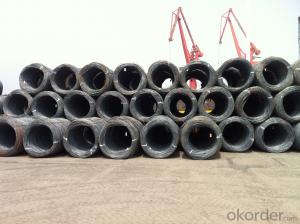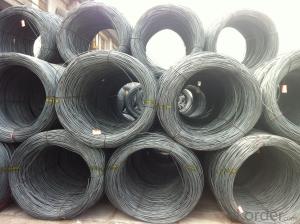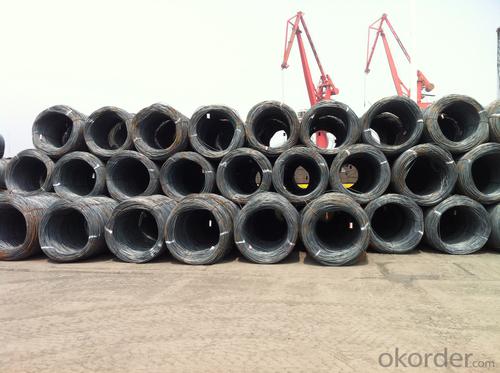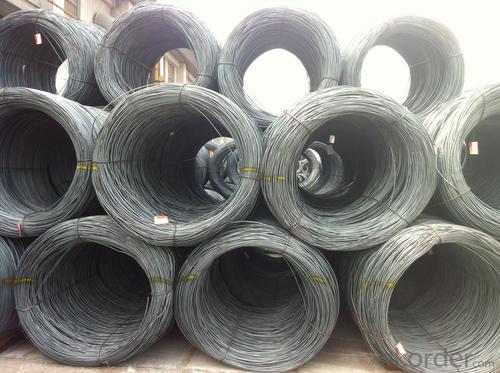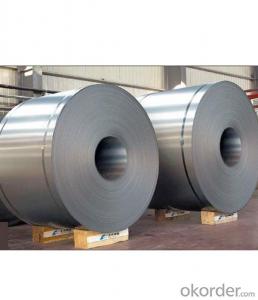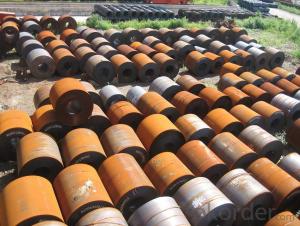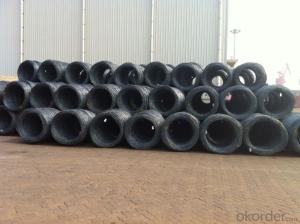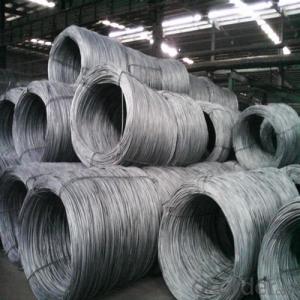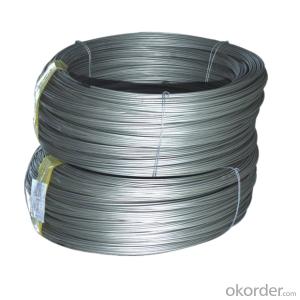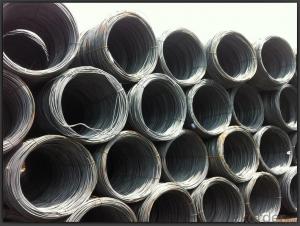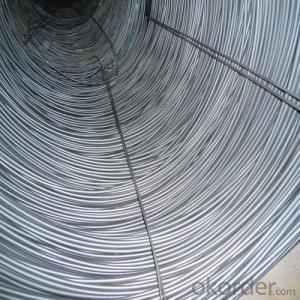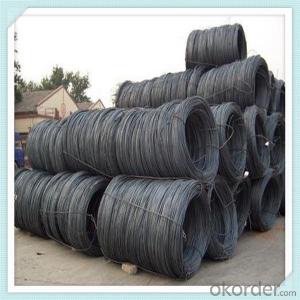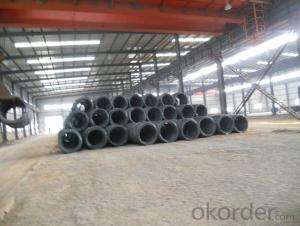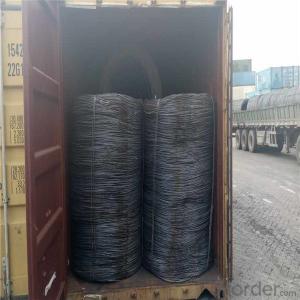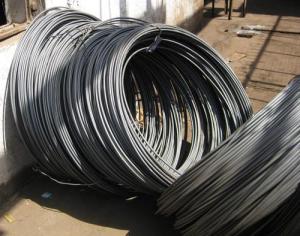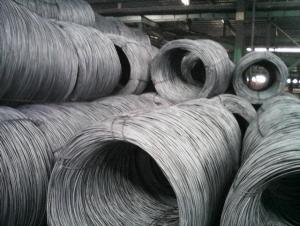Low Carbon Hot Rolled Wire rods in Grade SAE1008
- Loading Port:
- Tianjin
- Payment Terms:
- TT OR LC
- Min Order Qty:
- 25 m.t
- Supply Capability:
- 20000 m.t/month
OKorder Service Pledge
OKorder Financial Service
You Might Also Like
OKorder is offering Carbon Steel Wire Rod at great prices with worldwide shipping. Our supplier is a world-class manufacturer of steel, with our products utilized the world over. OKorder annually supplies products to European, North American and Asian markets. We provide quotations within 24 hours of receiving an inquiry and guarantee competitive prices.
Product Applications:
Carbon Steel Wire Rod are ideal for structural applications and are widely used in the construction of buildings and bridges, and the manufacturing, petrochemical, and transportation industries.After hot-rolled the products shaped into coil and delivery as finished product, including round, square, rectangular, hexagonal and so on. Since most of the products are round, it is generally called wire rod. Carbon steel wire rod is widely used in construction and manufacturing. Carbon steel wire rod is mainly used for reinforcement of reinforced concrete and welded structure or reprocessed (roberts , nail, etc.) materials, especially used to produce wire drawing, welding electrode, nails, spring, electronic, precise machinery parts and so on.
Product Advantages:
OKorder's Carbon Steel Wire Rod are durable, strong, and resist corrosion.
Main Product Features:
· Premium quality
· Prompt delivery & seaworthy packing (30 days after receiving deposit)
· Corrosion resistance
· Can be recycled and reused
· Mill test certification
· Professional Service
· Competitive pricing
Product Specifications:
Chemical Composition:
Please kindly find our chemistry of our material based on SAE1006/SAE1008 as below for your information
Grade | Chemical Composition (%) | |||||
C | Mn | S | P | Si | B | |
SAE1006 | 0.03~O.07 | 0.32max | 0.045max | 0.040max | 0.30max | 0.0008min |
Mechanical properties | ||||||
Yield strength(N/mm2) | Tensile strength(N/mm2) | Elongation (%) | ||||
250-280 | 350-380 | ≥32 | ||||
Grade | Chemical Composition (%) | |||||
C | Mn | S | P | Si | B | |
SAE1008 | 0.10max | 0.3~0.50 | 0.050max | 0.040 max | 0.15max | 0.0008 min |
Mechanical properties | ||||||
Yield strength(N/mm2) | Tensile strength(N/mm2) | Elongation (%) | ||||
≥195 | 315-430 | ≥30 | ||||
FAQ:
Q1: Why buy Materials & Equipment from OKorder.com?
A1: All products offered byOKorder.com are carefully selected from China's most reliable manufacturing enterprises. Through its ISO certifications, OKorder.com adheres to the highest standards and a commitment to supply chain safety and customer satisfaction.
Q2: What's your shipment type ?
A2: Usually we ship the goods by bulk vessel,if you want load them by container vessels,we can arrange as well .
Q3: How soon we can delivery the goods ?
A3: We have a mill with 20000mts of capacity per month. We can delivery the goods within one month.
Image:
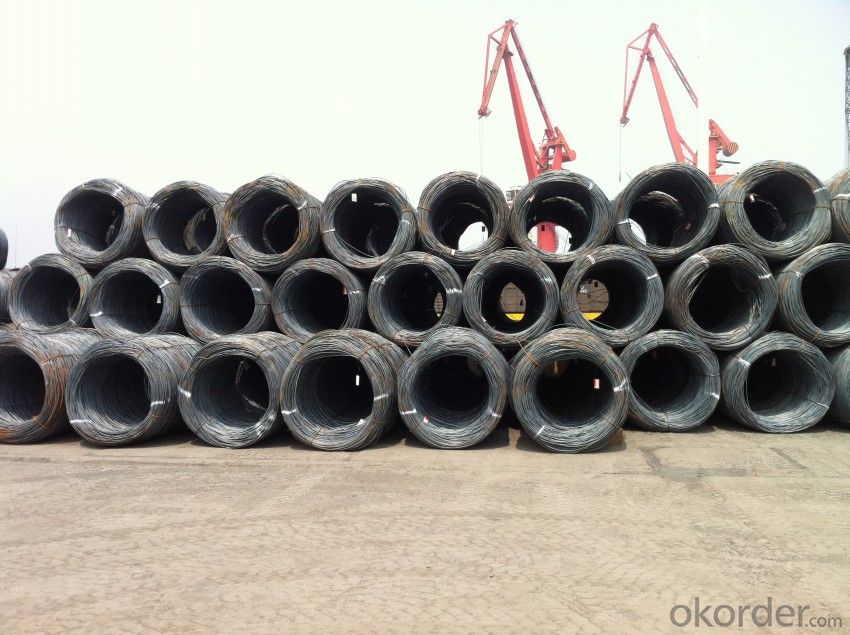
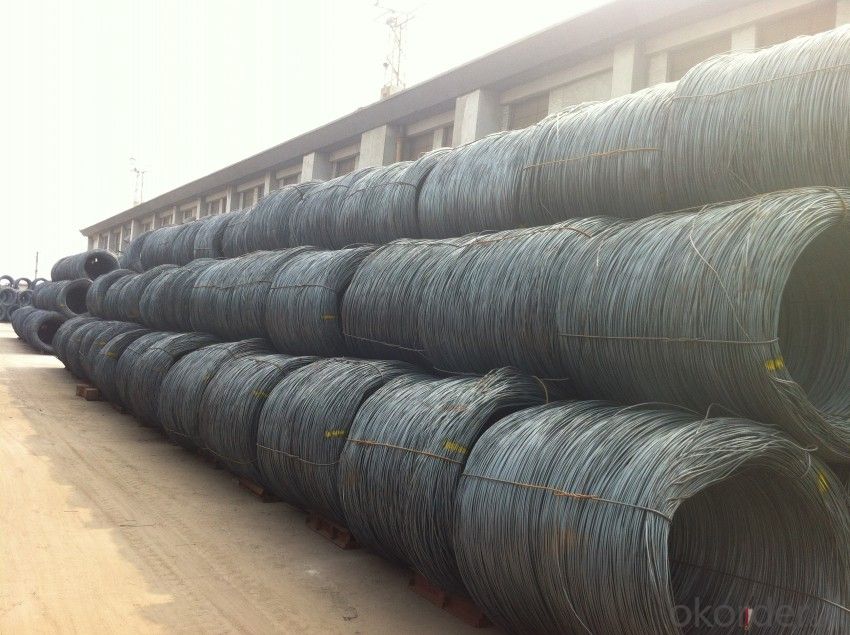
- Q: What are the main trends in the steel wire rod industry?
- Some of the main trends in the steel wire rod industry include increasing demand for steel wire rods in various sectors such as construction, automotive, and manufacturing due to their strength and versatility. Additionally, there is a growing emphasis on sustainability and eco-friendly practices, leading to the development of more environmentally-friendly steel wire rods. Furthermore, technological advancements and automation are playing a significant role in improving efficiency and productivity in the industry. Lastly, globalization and international trade are influencing the market dynamics, with emerging economies becoming key players in the production and consumption of steel wire rods.
- Q: What are the main factors influencing the choice of steel wire rod technical support?
- The main factors influencing the choice of steel wire rod technical support can vary depending on the specific needs and requirements of the industry or company. However, there are several common factors that play a significant role in this decision-making process. One of the key factors is the technical expertise and knowledge of the support provider. The chosen technical support team should have a deep understanding of steel wire rod production processes, equipment, and technologies. They should have the necessary experience and expertise to provide guidance and solutions for any technical challenges that may arise during production. Another important factor is the reliability and responsiveness of the technical support team. Steel wire rod production processes can be time-sensitive, and any technical issues or breakdowns can lead to costly production delays. Therefore, having a responsive technical support team that can quickly address and resolve any issues is crucial for ensuring smooth and uninterrupted production. The availability of comprehensive technical support services is also a significant factor. This includes not only troubleshooting and resolving technical issues but also providing guidance and assistance in areas such as process optimization, equipment maintenance, and quality control. A comprehensive technical support provider can offer a holistic approach to enhancing the overall efficiency and productivity of the steel wire rod production process. Cost is another important consideration. Companies need to evaluate the cost-effectiveness of the technical support services offered. This involves considering factors such as the upfront cost of the support, ongoing maintenance expenses, and the potential cost savings or productivity improvements that can be achieved through the use of the support services. Furthermore, the reputation and track record of the technical support provider are essential factors to consider. It is crucial to choose a provider with a proven track record of delivering high-quality technical support services to ensure reliability and effectiveness. Lastly, the compatibility and integration of the technical support services with the existing infrastructure and systems should be evaluated. The chosen support provider should be able to seamlessly integrate their services into the existing production processes and systems, minimizing disruptions and maximizing efficiency. In conclusion, the main factors influencing the choice of steel wire rod technical support include technical expertise, reliability and responsiveness, comprehensive services, cost-effectiveness, reputation, and compatibility. Considering these factors will help companies make an informed decision that meets their specific needs and requirements.
- Q: What are the different surface defects that can impact the weldability of steel wire rod?
- Some of the different surface defects that can impact the weldability of steel wire rod include scale, rust, mill scale, oxide layers, and surface contaminants. These defects can interfere with the formation of a clean and strong weld, leading to reduced weld quality and performance.
- Q: What are the main challenges in recycling steel wire rod?
- Recycling steel wire rod presents several primary challenges. To begin with, the collection and sorting of steel wire rod pose a major obstacle. Steel wire rod exists in various forms and sizes, making it difficult to separate from other materials during recycling. Advanced sorting technologies and efficient collection systems are necessary to ensure that only steel wire rod is recycled and other materials are appropriately sorted. Another challenge arises from the presence of contaminants in steel wire rod. Coatings like zinc or other metals frequently accompany steel wire rod and must be removed before recycling. These coatings can impede the quality of the recycled steel and may necessitate additional processing steps to guarantee the purity of the final product. Additionally, recycling steel wire rod is energy-intensive. The melting process employed in recycling requires high temperatures and consumes a substantial amount of energy. This presents challenges in terms of both cost and environmental impact, as it contributes to greenhouse gas emissions and demands significant energy resources. Moreover, the transportation and logistics involved in recycling steel wire rod can be problematic. Steel wire rod is often bulky and heavy, leading to increased transportation costs and necessitating specialized equipment for handling and processing. The logistics of collecting, transporting, and storing steel wire rod for recycling can be intricate and require efficient coordination to ensure a smooth recycling process. Lastly, fluctuations in market demand for recycled steel wire rod can create challenges for recycling facilities. The demand for steel wire rod is influenced by economic conditions, construction activities, and infrastructure development. During periods of low market demand, recycling facilities may struggle to find buyers for their recycled steel wire rod, impacting the profitability and viability of the recycling process. In conclusion, the primary challenges in recycling steel wire rod encompass collection and sorting, removal of contaminants, energy consumption, transportation and logistics, and market demand fluctuations. Addressing these challenges necessitates technological advancements, efficient processes, and a strong market demand for recycled steel wire rod.
- Q: How does the brittleness of steel wire rod vary with different heat treatment processes?
- The brittleness of steel wire rod can vary significantly with different heat treatment processes. Heat treatment involves subjecting the steel wire rod to specific temperature and time conditions to alter its microstructure and consequently its mechanical properties. One commonly used heat treatment process is annealing, which involves heating the steel wire rod to a specific temperature and then slowly cooling it. This process helps to relieve internal stresses, refine the microstructure, and improve the ductility of the wire rod. As a result, annealed steel wire rod tends to have reduced brittleness and increased toughness. On the other hand, quenching is another heat treatment process that involves rapidly cooling the steel wire rod after heating it to a specific temperature. Quenching can result in the formation of a hardened microstructure, known as martensite, which can increase the strength of the wire rod. However, this process can also increase the brittleness of the material. Therefore, quenched steel wire rod tends to be more brittle compared to annealed wire rod. Another heat treatment process, known as tempering, is often used in conjunction with quenching to reduce the brittleness of the wire rod. Tempering involves reheating the quenched wire rod to a lower temperature, which allows for the redistribution of internal stresses and the transformation of some of the martensite into a more ductile microstructure. This process helps to improve the toughness and reduce the brittleness of the wire rod. In summary, the brittleness of steel wire rod can be influenced by different heat treatment processes. Annealing generally reduces brittleness and improves ductility, while quenching can increase brittleness but enhance strength. Tempering can then be used to reduce brittleness after quenching. The selection of the appropriate heat treatment process depends on the desired mechanical properties and the intended application of the steel wire rod.
- Q: How is steel wire rod tested for reduction in area?
- Steel wire rod is tested for reduction in area by subjecting it to a tensile testing process. A specimen of the wire rod is gripped at both ends and gradually pulled until it breaks. The reduction in cross-sectional area of the specimen at the point of fracture is measured and compared to the original cross-sectional area. This provides a measure of the wire rod's ability to withstand deformation without breaking and is an important factor in determining its overall strength and quality.
- Q: How are steel wire rods used in the manufacturing of piano strings?
- Piano strings are made using steel wire rods, which are essential for their production. The strength and durability of steel make it an ideal material for creating strings that can handle the high tension required to produce the desired sound in a piano. To start the manufacturing process, careful selection is done to choose high-quality steel wire rods with specific properties. These rods are typically made of high-carbon steel, providing the necessary strength and resilience for piano strings. Once the steel wire rods are selected, they go through a series of processes to turn them into piano strings. Firstly, the rods are drawn through dies to decrease their diameter and increase their length. This wire drawing process ensures that the wire has the correct thickness for the desired pitch of the piano string. After wire drawing, the steel wire rods undergo annealing and tempering. Annealing involves heating the wire to a precise temperature and then slowly cooling it, enhancing flexibility and reducing internal stresses. On the other hand, tempering includes reheating the wire to a lower temperature and rapidly cooling it, improving its strength and elasticity. Once the steel wire rods have been annealed and tempered, they are ready to be transformed into piano strings. The wire is cut into specific lengths and tightly wound around a core wire, usually made of copper or steel. The winding process is carefully controlled to ensure uniformity and precision in the string's diameter and tension. Finally, the wound strings undergo additional processes like polishing and coating to enhance their durability and tonal quality. These processes protect the strings from corrosion and wear, ensuring that they maintain their sound and longevity over time. In conclusion, steel wire rods are utilized in the manufacturing of piano strings due to their high tensile strength and durability. Through processes like wire drawing, annealing, tempering, and winding, these steel rods are transformed into strings that can withstand high tension and produce the desired sound in a piano.
- Q: 8 wire rods, one meter, how many kilograms?
- Round steel rod (kg/m) W= 0.006165 * D * d d = diameter mm, diameter 100 mm round steel, for every m weight. Weight per M = 0.006165 * 1002=61.65kg
- Q: How is steel wire rod used in the production of reinforcement bars?
- Steel wire rod is used in the production of reinforcement bars by being heated and passed through a series of dies to form the desired shape and size. This process, known as hot rolling, helps strengthen the steel wire rod and enhances its ductility, making it suitable for use in reinforcement bars. The reinforcement bars, also known as rebars, are then used to provide strength and support to concrete structures, such as buildings, bridges, and highways, by reinforcing them against tension and bending forces. Overall, steel wire rod plays a vital role in the production of reinforcement bars, ensuring the durability and structural integrity of various construction projects.
- Q: What are the different types of wire mesh made from steel wire rod?
- There are several different types of wire mesh that are made from steel wire rod. Some of the most common types include: 1. Welded Wire Mesh: This type of wire mesh is made by welding the steel wire rods together at the intersections, forming a grid pattern. It is often used for fencing, security enclosures, and reinforcement in concrete structures. 2. Woven Wire Mesh: This type of wire mesh is created by weaving the steel wire rods together in an interlocking pattern. It is available in different weave styles, such as plain weave, twill weave, and Dutch weave. Woven wire mesh is commonly used for filtration, screening, and separation applications. 3. Expanded Metal Mesh: This type of wire mesh is made by cutting and stretching the steel wire rods, creating a mesh with diamond-shaped openings. Expanded metal mesh is lightweight, strong, and versatile, making it suitable for various applications, including walkways, security grilles, and decorative panels. 4. Perforated Metal Mesh: This type of wire mesh is produced by punching holes into the steel wire rods, creating a pattern of openings. Perforated metal mesh is often used for architectural purposes, such as facades and sunscreens, as well as for filtration, ventilation, and acoustic control. 5. Knitted Wire Mesh: This type of wire mesh is made by knitting the steel wire rods together, forming a flexible and resilient structure. Knitted wire mesh is commonly used for gaskets, seals, and filtration applications, as it can provide high levels of gas and liquid filtration. These are just a few examples of the different types of wire mesh that can be made from steel wire rods. Each type has its own unique characteristics and applications, making them suitable for a wide range of industrial and commercial purposes.
Send your message to us
Low Carbon Hot Rolled Wire rods in Grade SAE1008
- Loading Port:
- Tianjin
- Payment Terms:
- TT OR LC
- Min Order Qty:
- 25 m.t
- Supply Capability:
- 20000 m.t/month
OKorder Service Pledge
OKorder Financial Service
Similar products
Hot products
Hot Searches
Related keywords
